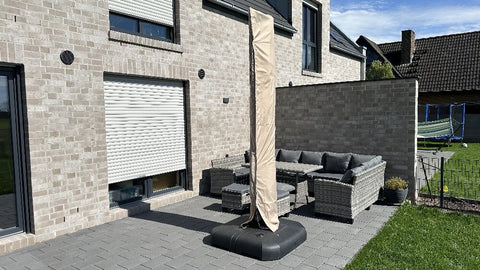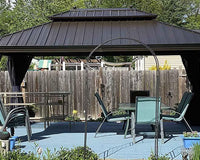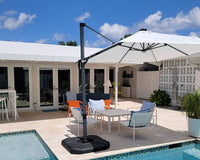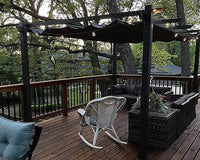Although Cantilever umbrellas are a fashionable and useful addition to any outdoor area, exposure to the elements means their canopies sometimes require replacing. Along with improving the cosmetic attractiveness of your umbrella, a fresh canopy guarantees ongoing protection from sun and rain. This article will provide a thorough tour on how to evaluate your present umbrella, choose the ideal new canopy, and easily finish the installation.
What's the Condition of Your Cantilever Umbrella Canopy?
You should assess the state of your present cantilever umbrella canopy before starting the replacement process. Look for indications of wear and tear, including fading, cloth thinning, rips, or a faulty mechanism that can compromise the installation of the new canopy. Look for structural damage to the pole and ribs that can affect their usefulness.
Equally important is identifying your umbrella's make and model. This information is crucial for purchasing the correct size and style of the replacement canopy. Typically, you'll find a label attached to the frame or the existing canopy with this information. If the label is not present or legible, you might find the model number in the original purchase documents or by contacting the manufacturer directly with photos of your umbrella for identification. Ensuring you have the right match will save time and guarantee a smooth transition to your new canopy.

What to Consider When Selecting a New Canopy?
The fabric type is paramount; options such as polyester, olefin, and acrylic offer varying degrees of durability and UV protection. Look for fabrics that are solution-dyed for fade resistance and have a high UPF rating to ensure maximum protection against the sun's rays.
Lighter colors reflect sunlight and retain less heat, while darker shades can provide better UV protection but may fade quicker. Additionally, consider the style and pattern that will complement your outdoor décor.
To guarantee compatibility and quality, choose reliable merchants either directly from the umbrella manufacturer or reputable dealers specializing in patio furniture when shopping. Although online markets like Amazon could provide convenience, always review consumer comments and return policies. Local home improvement stores could also have canopies and usually offer useful guidance on choosing the best one.
What Tools Will You Need for Canopy Replacement?
Before beginning your canopy replacement, gather the necessary tools and materials to ensure a smooth process. You'll typically need:
- A ladder to reach the canopy safely.
- A set of screwdrivers or a drill for unscrewing any attached hardware.
- Pliers to help with stubborn or rusted parts.
- Protective gloves to guard your hands against sharp edges.
Once you have your tools ready, follow these steps to dismantle your current canopy:
1. Position your ladder securely and wear gloves.
2. Start by carefully removing any screws or fasteners connecting the canopy to the umbrella frame, using a screwdriver or drill.
3. Gently release any tension mechanisms or ties.
4. Slowly lift off the old fabric from the frame, paying attention not to damage the arms of the umbrella.
5. With the fabric removed, inspect the frame for damage that may need addressing before installing the new canopy.
How to Attach the New Canopy Correctly
Follow these detailed instructions for a smooth attachment:
- Spread the replacement canopy on a clean, flat surface to identify the top and bottom sides.
- Position the frame over the canopy, aligning any pockets or corners designed to fit the ends of the umbrella arms.
- Begin by attaching the canopy's corners to the frame's end points, which often involves Velcro straps or pockets.
- Secure the fabric around the central hub of the umbrella frame, ensuring it’s evenly spread without any twists.
Avoid these common pitfalls during attachment:
1. Rushing the Process: Take your time to ensure each section is fitted correctly; haste can lead to misalignment.
2. Mismatched Parts: Make sure the attachment points on the new canopy correspond exactly with those on your frame.
3. Forcing Fabric: If the fabric doesn't seem to fit, double-check you have the correct side facing up and that it's designed for your model.
4. Ignoring Weather: Don’t attempt installation on a windy day, as this could make the process more difficult and potentially damage the new canopy.

Adjust and Secure the New Canopy
Once the new canopy is attached to the frame, proper adjustment is key to ensuring it functions correctly and looks its best. Start by gently spreading out the canopy to eliminate any folds or creases. Adjust the tension by pulling the fabric evenly at the corners; this will prevent sagging and ensure that the canopy retains its shape over time.
For alignment, check that the fabric is symmetrical along the ribs of the umbrella frame. If your canopy has tie-downs or Velcro straps, fasten them securely but without over-tightening, which could cause the material to tear.
Make sure all fasteners are tight and the canopy is taut enough to minimise wind-flapping, which can cause wear, therefore securing the canopy against environmental conditions. To increase the lifetime of the umbrella, it is suggested to close it or remove the canopy if at all possible, though, especially during severe weather.
Maintenance Tips for Your New Canopy
Regular maintenance is crucial to extend the life of your new cantilever umbrella canopy.
Brush off loose dirt and rinse with lukewarm water regularly. For a deeper clean, use a mild soap solution and a soft-bristled brush to gently scrub any spots. Avoid harsh cleaners or bleach, which can damage the fabric and cause discoloration.
After cleaning, allow the canopy to dry completely before closing or covering it. This helps prevent mold and mildew growth, which can degrade the material over time.
If your canopy isn’t built for all-weather conditions, consider removing and storing it during harsh weather seasons. Store the fabric in a cool, dry place, away from direct sunlight and moisture.
Periodically inspect the canopy for signs of wear or damage, addressing any issues promptly to prevent further deterioration.
Wrapping Up Your Canopy Replacement
Your new canopy will be ready for use once it is firmly in place and furnished with care advice. Regular maintenance is the secret to longevity; a little attention over the seasons will make sure your umbrella is the center point of comfort and design for years to come. Accept these actions into your daily practice, and you will find it easy to maintain your oasis in perfect condition.






3 comments
marlene mauer
I need to replace the canopy of my umbrella (material only) how do I do this? My number is 801.440.6254
STEPHEN W. ORFEI
I HAVE PURCHASE 3 CANTILEVER UMBRELLAS IN NAVY BLUE, ONE ( 11 X 11 ) AND TWO ( 10 X 13 ) ON AMAZON JUNE 2022. ALONG WITH THREE INGOUND BASES.
I NEED TO REPLACE THE CANOPYS ONLY ( MATERIAL ). YOUR ASSISTANCE PLEASE REQUIRED. LOVE THE PRODUCT.
STEPHEN
Steve highbaugh
Need to replace my canopy on my 13 foot round cantilever umbrella and can’t locate it in web site trid but o ky shows 4 pictures none of the canopy replacement